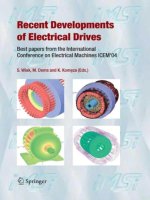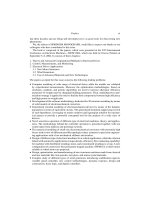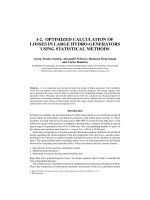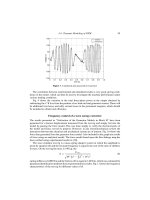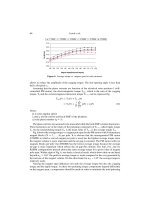Recent Developments of Electrical Drives - Part 1 potx
Bạn đang xem bản rút gọn của tài liệu. Xem và tải ngay bản đầy đủ của tài liệu tại đây (85.86 KB, 10 trang )
RECENT DEVELOPMENTS OF ELECTRICAL DRIVES
Recent Developments
of Electrical Drives
Best papers from the International Conference
on Electrical Machines ICEM’04
Edited by
S. Wiak, M. Dems, and K. Kom˛eza
Technical University of Lodz, Poland
A C.I.P. Catalogue record for this book is available from the Library of Congress.
ISBN-10 1-4020-4534-4 (HB)
ISBN-13 978-1-4020-4534-9 (HB)
ISBN-10 1-4020-4535-2 (e-book)
ISBN-13 978-1-4020-4535-6 (e-book)
Published by Springer,
P.O. Box 17, 3300 AA Dordrecht, The Netherlands.
www.springer.com
Printed on acid-free paper
All rights reserved.
C
2006 Springer
No part of this work may be reproduced, stored in a retrieval system, or transmitted
in any form or by any means, electronic, mechanical, photocopying, microfilming, recording or otherwise,
without written permission from the Publisher, with the exception
of any material supplied specifically for the purpose of being entered
and executed on a computer system, for exclusive use by the purchaser of the work.
Printed in the Netherlands.
CONTENTS
Preface
S. Wiak, M. Dems and K. Kom
˛
eza ix
I. Theory and Advanced Computational Methods in Electrical Drives
1. Core Loss in Turbine Generators: Analysis of No-Load Core Loss by 3D
Magnetic Field Calculation
A. Nakahara, K. Takahashi, K. Ide, J. Kaneda, K. Hattori, T. Watanabe,
H. Mogi, C. Kaido, E. Minematsu and K. Hanzawa 3
2. Optimised Calculation of Losses in Large Hydro-Generators
Using Statistical Methods
G. Traxler-Samek, A. Schwery, R. Zickermann and C. Ramirez 13
3. Coupled Model for the Interior Type Permanent Magnet Synchronous
Motors at Different Speeds
M. P´erez-Donsi´on 25
4. Dynamic Modeling of a Linear Vernier Hybrid Permanent Magnet
Machine Coupled to a Wave Energy Emulator Test Rig
M.A. Mueller, J. Xiang, N.J. Baker and P.R.M. Brooking 39
5. Finite Element Analysis of Two PM Motors with Buried Magnets
J. Kolehmainen 51
6. Design Technique for Reducing the Cogging Torque in Large
Surface-Mounted Magnet Motors
R. Lateb, N. Takorabet, F. Meibody-Tabar, J. Enon and A. Sarribouette 59
7. Overlapping Mesh Model for the Analysis of Electrostatic
Microactuators with Eccentric Rotor
P. Rembowski and A. Pelikant 73
8. Coupled FEM and System Simulator in the Simulation of Asynchronous
Machine Drive with Direct Torque Control
S. Kanerva, C. Stulz, B. Gerard, H. Burzanowska, J. J¨arvinen and S. Seman 83
v
vi Contents
9. An Intuitive Approach to the Analysis of Torque Ripple in Inverter
Driven Induction Motors
¨
O. G¨ol, G A. Capolino and M. Poloujadoff 93
10. Vibro-Acoustic Optimization of a Permanent Magnet Synchronous
Machine Using the Experimental Design Method
S. Vivier, A. Ait-Hammouda, M. Hecquet, B. Napame,
P. Brochet and A. Randria 101
11. Electromagnetic Forces and Mechanical Oscillations of the Stator End
Winding of Turbo Generators
A. Gr¨uning and S. Kulig 115
12. Optimization of a Linear Brushless DC Motor Drive
Ph. Dessante, J.C. Vannier and Ch. Ripoll 127
II. Control, Measurements, and Monitoring
1. A General Description of High-Frequency Position Estimators for
Interior Permanent-Magnet Synchronous Motors
F.M.L.L. De Belie, J.A.A. Melkebeek, K.R. Geldhof,
L. Vandevelde and R.K. Boel 141
2. Sensorless Control of Synchronous Reluctance Motor Using Modified
Flux Linkage Oberver with an Estimation Error Correct Function
T. Hanamoto, A. Ghaderi, T. Fukuzawa and T. Tsuji 155
3. A Novel Sensorless Rotor-Flux-Oriented Control Scheme with Thermal
and Deep-Bar Parameter Estimation
M.J. Duran, J.L. Duran, F. Perez and J. Fernandez 165
4. Wide-Speed Operation of Direct Torque-Controlled Interior
Permanent-Magnet Synchronous Motors
A. Muntean, M.M. Radulescu and A. Miraoui 177
5. Optimal Switched Reluctance Motor Control Strategy for Wide Voltage
Range Operation
F. D’hulster, K. Stockman, I. Podoleanu and R. Belmans 187
6. Effect of Stress-Dependent Magnetostriction on Vibrations of an
Induction Motor
A. Belahcen 201
Contents vii
7. Comparison of Stator- and Rotor-Force Excitation for the Acoustic
Simulation of an Induction Machine with Squirrel Cage Rotor
C. Schlensok and G. Henneberger 211
8. A Contribution to Determine Natural Frequencies of Electrical
Machines. Influence of Stator Foot Fixation
J.P. Lecointe, R. Romary and J.F. Brudny 225
9. Diagnosis of Induction Machines: Definition of Health Machine
Electromagnetic Signature
D. Thailly, R. Romary and J.F. Brudny 237
10. Impact of Magnetic Saturation on the Input-Output Linearising
Tracking Control of an Induction Motor
D. Dolinar, P. Ljuˇsev and G.
ˇ
Stumberger 247
11. Direct Power and Torque Control Scheme for Space Vector Modulated
AC/DC/AC Converter-Fed Induction Motor
M. Jasinski, M.P. Kazmierkowski and M. Zelechowski 261
12. Experimental Verification of Field-Circuit Finite Element Models of
Induction Motors Feed from Inverter
K. Kom
˛
eza, M. Dems and P. Jastrzabek 275
III. Electrical Drives Applications
3.1. New Motor Structures
1. Design and Manufacturing of Steel-Cored Permanent Magnet Linear
Synchronous Motor for Large Thrust Force and High Speed
Ho-Yong Choi, Sang-Yong Jung and Hyun-Kyo Jung 295
2. High Pole Number, PM Synchronous Motor with Concentrated Coil
Armature Windings
A. Di Gerlando, R. Perini and M. Ubaldini 307
3. Axial Flux Surface Mounted PM Machine with Field Weakening
Capability
J.A. Tapia, D. Gonzalez, R.R. Wallace and M.A. Valenzuela 321
4. Comparison Between Three Iron-Powder Topologies of Electrically
Magnetized Synchronous Machines
D. Mart´ınez-Mu˜noz, A. Reinap and M. Alak¨ula 335
viii Contents
5. Recent Advances in Development of the Die-Cast Copper Rotor Motor
E.F. Brush Jr., D.T. Peters, J.G. Cowie, M. Doppelbauer
and R. Kimmich 349
3.2. Wind Generators
1. Performance Analysis of a Doubly Fed Twin Stator Cage
Induction Generator
F. R ¨uncos, R. Carlson, N. Sadowski and P. Kuo-Peng 361
2. Static and Dynamic Measurements of a Permanent Magnet Induction
Generator: Test Results of a New Wind Generator Concept
G. Gail, T. Hartkopf, E. Tr¨oster, M. H¨offling,
M. Henschel and H. Schneider 375
3. Maximum Wind Power Control Using Torque Characteristic in a Wind
Diesel System with Battery Storage
M. El Mokadem, C. Nıchıta, B. Dakyo and W. Koczara 385
4. Study of Current and Electromotive Force Waveforms in Order to
Improve the Performance of Large PM Synchronous Wind Generator
D. Vizireanu, S. Brisset, P. Brochet, Y. Milet and D. Laloy 397
3.3. Use of Advanced Materials and New Technologies
1. Equivalent Thermal Conductivity of Insulating Materials for High
Voltage Bars in Slots of Electrical Machines
P. G. Pereirinha and C. L. Antunes 413
2. Loss Calculations for Soft Magnetic Composites 423
G. Nord, L.O. Pennander and A. Jack
3. Electroactive Materials: Towards Novel Actuation Concepts 435
B. Nogarede, J.F. Rouchon and A. Renotte
4. Advanced Materials for High Speed Motor Drives
G. Kalokiris, A.G. Kladas and J.A.Tegopoulos 443
5. Improved Modeling of Three-Phase Transformer Analysis Based on
Nonlinear B-H Curve and Taking into Account Zero-Sequence Flux
B. Kawkabani and J.J. Simond 451
PREFACE
Selected papers for SPRINGER MONOGRAPH, after final reviewing process were pre-
sented at the XVI Inter national Conference on Electrical Machines ICEM’2004 which was
held in Cracow, Poland, on September 5–8, 2004.
The International Conference on Electrical Machines (ICEM) is the only major interna-
tional conference devoted entirely to electrical machines. Started in London in 1974, ICEM
is now established as a regular biennial event. Following the very successful conferences
in Istanbul in 1998, Helsinki in 2000, and Belgium in 2002 ICEM’2004 was jointly orga-
nized by Institute of Mechatronics and Information Systems, Technical University of L ´od´z,
Poland (main organizer) in cooperation with a few Polish Universities and Polish Society
of Applied Electromagnetics.
The Conference venue was Cracow. Historically, Cracow is Poland’s most distinguished
city, on a par with the most famous places in Europe, comprising rich and varied cultural
heritage. The ancient royal capital of Poland for centuries has been constituting crossroads
where influences of many traditions meet, namely traditions of the Italian, French, German,
Austrian, and Jewish cultures.
Cracow’s uniqueness made it one of the first places to be entered on the UNESCO World
Cultural Heritage List in 1978. Alongside hundreds of wonderful monuments of architec-
ture, you will see here exquisite collections of Polish, Western European, Jewish, Persian,
and Japanese art. Cracow is the city of Copernicus and Pope John Paul II, of Penderecki
and Wajda. It is a city of churches and museums, theatres and festivals, scholarship and
music, a city brimming with life, and as ever the focus of Poland’s cultural and academic
spirit.
The aim of the Conference is to discuss recent developments of modeling and simula-
tion methodologies, control systems, testing, measurements, monitoring and diagnostics,
advanced software methodology, etc., applied in electrical drives. The meeting is intended
to be a forum for applied mathematicians, computer and software engineers, and electrical
engineers to exchange ideas, experience on the new developments, trends, and applications
from industrial and academic viewpoints on the topic. An important goal of ICEM is also
stimulating personal contacts and cooperation, especially between industrial and academic
institutions.
Almost 930 papers have been submitted as digests, and after reviewing process, in which
two referees havereviewed each paper, 525papers have beenaccepted for the presentationat
the Conference. Over 430 papers in full versions, after final reviewing, have been published
on CD as Conference Proceeding. The papers published in the Conference Proceeding
have been refereed by the sessions’ chairmen for further publication as post conference
issue. It is the tradition of the ICEM meetings that they comprise quite a vast area of
computationaland appliedproblems.Moreover, theICEMconferences aimat joiningtheor y
and practice, thus the majority of papers are deeply rooted in engineering problems, being
ix
x Preface
simultaneously of high theoretical level. A knowledge of physical phenomena is necessary
for understanding the operation of electromagnetic devices, electromechanical converters,
and electronic systems in general, such as sensors, actuators, solid state devices, integrated
circuits, and Micro Electro Mechanical Systems (MEMS). In general the coexistence of
electric, magnetic, thermal, and mechanical effects characterizes the global behavior of
any electrical drives or systems. The main topics of ICEM’2004 meeting are listed below,
selected to either oral or poster session:
Oral Session
r
Industrial Applications
r
Permanent Magnet Machines
r
Special Machines
r
Control Drives and Generators
r
Controlled Drives for Special Applications
r
Controlled Drives for Special Applications, Actuators
r
Finite Element Methodology
r
Modeling and Simulation
r
Modeling and Simulation of Induction Motors
r
Wind Generators
r
Thermal, Acoustic Noise, and Vibration Aspects
r
Testing, Measurements, Monitoring, and Diagnostics
r
Transformers, Special Machines
r
Use of Advanced Materials
r
Linear Drives
Poster Session
r
Permanent Magnet Machines
r
Special Machines
r
Special Machines, Actuators
r
Finite Element Methodology
r
Modeling and Simulation
r
Wind Generators
r
Thermal, Acoustic Noise, and Vibration Aspects
r
Testing, Measurements, Monitoring, and Diagnostics
r
Transformers, Use of Advanced Materials and New Technology
r
Control Drives and Generators
r
Linear Machines
It makes some order in reading but also it somehow represents the main directions, which
are penetrated by researchers dealing with modern electrical drives. Looking at the con-
tent of the book of digests one may also notice that the more and more researchers go
into the investigation of new applications of computer engineering, especially these con-
nected with software methodology, CAD techniques, system control, and material sci-
ences. The computational techniques, which have been under development during the

